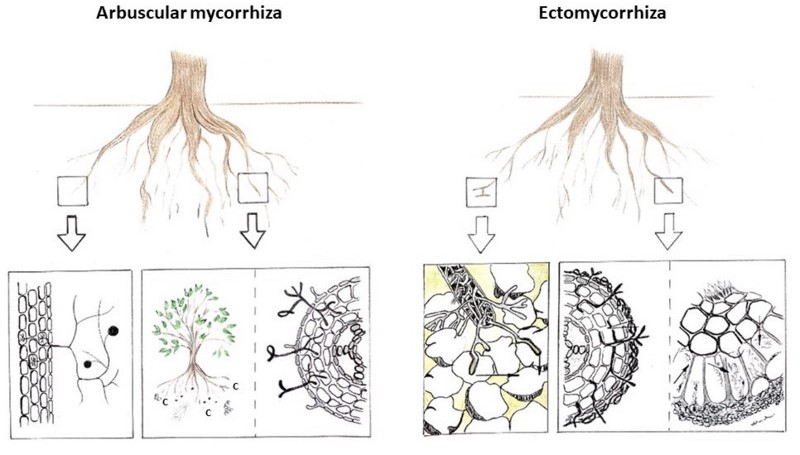Mycorrhiza Research
Ongoing Projects

ERC Starting Grant:
Mycorrhizal Types and Soil Carbon Storage - A mechanistic theory of fungal mediated soil organic matter cycling in temperate forests (Myco-SoilC)
from 06/2022 to 05/2027
PhD students: Valentin Kurbel, Myrthe Detiger
PostDocs: Dr. Khatab Abdalla, Nicolas Tyborski
The world's soils are the largest terrestrial reservoir of organic carbon (C). Feedbacks between soil organic C and atmospheric CO2 will determine the future trajectory of climate change. However, predictions are largely uncertain because we still lack fundamental knowledge of the complex interplay between plants and microorganisms and its influence on C turnover. Most terrestrial plants live in symbiosis with mycorrhizal fungi. Previous work suggests that on a global scale soil C stocks are linked to the distribution of arbuscular mycorrhizal (AM) or ectomycorrhizal (ECM) plants. To date, it is not clear whether there is a causal relationship between mycorrhizal type and soil C storage. Answering this key question requires novel concepts that consider the mechanistic link between short-term C fluxes from plants to mycorrhizal fungi and C storage as emerging ecosystem properties.

Characteristic features of arbuscular and ectomycorrhiza. Drawing by Katrin Giesemann.
Collaborative partners: Prof. Dr. Richard Phillips; Dr. Robert Koller; Dr. Matthias Gube
How mycorrhizal types and tree diversity drive soil carbon stabilization
(Myco-Div)
from 05/2023 to 05/2026
PhD student: Christina Marburger
Collaborative Partners: Prof. Dr. Ina Meier; MyDiv
In temperate forests, the symbiosis between trees and fungi, the mycorrhiza, plays an important role for soil C storage. Forests dominated by trees with ectomycorrhiza (ECM) were shown to have higher C stocks compared to forests with arbuscular mycorrhiza (AM). However, previous results suggest that these C stocks are less stabilized. To date, a mechanistic understanding of the factors and processes by which different types of mycorrhiza influence C stocks in particulate and mineral-associated organic matter fractions is still lacking. We hypothesize that the mycorrhizal type influences rhizodeposition, particularly the metabolite diversity and the dynamics of C-input and is thus a key driver for soil C stabilization. We propose that in AM-dominated forests, a small but continuous input of highly diverse rhizodeposits promotes microbial communities that then contribute to increased C stabilization in the form of mineral-associated organic matter. In contrast, an infrequent and high C input, while suppressing saprotrophic fungi (Gadgil Effect), promotes particulate organic matter accumulation in ECM forests. The proposed project will contribute to a comprehensive understanding of mycorrhizal type-driven mechanisms of C turnover in temperate forests. This opens the possibility to better predict future changes in C stocks in forest ecosystems and to develop new forest management strategies to maintain or even increase soil C storage.
Texture Dependency of Arbuscular Mycorrhiza Induced Plant Drought Tolerance
(TeAM-uP)
from 05/2023 to 05/2026
PhD student: Henri Braunmiller
Collaborative Partners: Michael Bitterlich, Andrea Schnepf, Jan Jansa, Mutez Ali Ahmed
Root water uptake is an important process in terrestrial water cycles and low soil moisture limits this process. Because reduced root uptake of water and dissolved nutrients under scarcity of soil water is threatening plant productivity, drought is putting pressure on society and ecosystems, especially on the agricultural sector. Plants do not live ‘alone’. As key members of the root-associated microbiome, arbuscular mycorrhizal fungi (AMF) engage in mutualistic symbioses with most terrestrial plant species. While it is firmly established that AMF are essential for plant mineral nutrition, their contribution to water acquisition and drought tolerance of their hosts is still not well understood. The effects of AMF on plant water relations have been called context-dependent, transient and unpredictable. Considering the occurrence of AMF in nearly all soils across the globe and their unspecific relation with the majority of crop species, research that unravels the mechanisms involved in water acquisition of mycorrhizal plants is imperatively required. This project proposes a way forward to reveal the hidden mechanisms that let plants benefit from AMF under drought.

